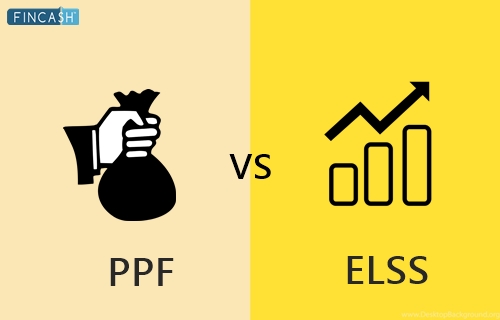ELSS Vs PPF: Is ELSS Better Than PPF?
ELSS vs PPF? Looking for an ideal investment to save Taxes this season? While there are various income tax saving schemes under which one can save their hard-earned money, ELSS and PPF options are the most favourable ones.

Before comparing these two options, let's first get a brief understanding of each of these individually.
ELSS Funds
Equity Linked Saving Schemes (ELSS) is a diversified Equity Fund that invests most of its assets in equities or stock markets. The minimum limit of Investing in ELSS Mutual Funds is INR 500 and there is no maximum limit. Also referred to as tax saving Mutual Funds, ELSS funds provide tax benefits and are liable for deductions under Section 80C of the Income Tax Act. Consider Best elss Funds offered by various Mutual Fund companies when buying Equity Linked Savings Schemes.
PPF or Public Provident Fund
Under the PPF Act of 1968, PPF was framed as one of the Tax Saving Scheme of the Central Government. Public Provident Fund is a long-term investment option that offers attractive interest rate. As PPF investment is backed by the Government of India, it is a safe investment option along with its amazing tax benefits, low maintenance cost and loan options.
Difference Between ELSS and PPF
There are various parameters to compare these two schemes. Below are a few of those -
Rate of Interest
For PPF, the interest rate is fixed while for the ELSS Mutual Funds the returns vary. As Public Provident Fund invests in government Bonds the interest rate is decided already. Currently, the interest rate of PPF is 7.10% p.a. Further, ELSS funds being invested in the equity markets, have variable returns. The returns can go fairly high or fairly low depending on the stock Market performance.
Lock-in Period
For both PPF and ELSS, there is a specified lock-in period. The PPF lock in period is 15 years, though you can withdraw a limited amount after 5 complete Financial Years. This makes it a long-term investment providing good returns. On the other hand, ELSS Mutual Funds have a short lock-in period of 3 years. This makes it suitable for fulfilling your immediate future needs.
Talk to our investment specialist
Risk Factors
PPF Funds are provided by the Government of India and offer fixed interest rates, so they are one of the safest possible investments in India. But, the ELSS Mutual Funds are riskier. It is a market linked investment thus having a higher risk probability. Though, some of the best ELSS Mutual Funds have the potential of providing good returns over a longer period of time.
Tax Deductions Under Section 80C of Income Tax Act
Both ELSS and PPF schemes are liable for tax benefits under section 80C of the Income Tax Act. For these investments, the tax deductions come under EEE (Exempt, Exempt, Exempt) category. Under this category, you do not have to pay tax in the entire investment cycle. So, initially the investment is tax-free, then the returns are tax-free and finally, the total income on investment is tax-free in the hands of the investor. So, the returns of both these funds are tax exempt and there is no taxation on the maturity amount.
Investment Limit
Under section 80C, one cannot invest more than INR 1,50,000 in PPF investments. For Equity Linked Saving Schemes, there is no maximum limit specified. Though the benefits can be availed only till an upper limit of INR 1,50,000.
Pre-mature Withdrawal
Closing ELSS and PPF Mutual Funds within the lock-in period is not allowed. Only in the case of demise of the account holder, the withdrawal of PPF funds is possible and that too with some penalties.
ELSS Vs PPF
Understand briefly about difference between ELSS vs PPF. The parameters used here are returns, tax exemption, lock-in, risk, etc.
Let's have a look-
| PPF (Public Provident Fund) | ELSS (Equity Linked Saving Scheme) |
|---|---|
| Being backed by the Government, PFF is safe | ELSS is volatile and risky |
| Fixed return- 7.10% p.a. | Expected return - 12-17% p.a. |
| Tax Exempt : EEE (Exempt, Exempt, Exempt) | Tax Exempt : EEE (Exempt, Exempt, Exempt) |
| Lock-in period - 15 years | Lock-in period- 3 years |
| Better suited for risk averse users | Better suited for risk takers |
| Can deposit up to INR 1,50,000 | No deposit limit |
Best ELSS Funds for 2025 - 2026
Fund NAV Net Assets (Cr) 3 MO (%) 6 MO (%) 1 YR (%) 3 YR (%) 5 YR (%) 2024 (%) HDFC Long Term Advantage Fund Growth ₹595.168
↑ 0.28 ₹1,318 1.2 15.4 35.5 20.6 17.4 HDFC Tax Saver Fund Growth ₹1,459.84
↑ 7.83 ₹17,194 2.1 4.7 7.2 20.4 22.5 21.3 Mirae Asset Tax Saver Fund Growth ₹50.847
↑ 0.31 ₹27,069 3.1 5.3 4.5 16.5 17.7 17.2 Aditya Birla Sun Life Tax Relief '96 Growth ₹62.59
↑ 0.35 ₹15,682 2.2 4.7 5.6 14.1 12.1 16.4 ICICI Prudential Long Term Equity Fund (Tax Saving) Growth ₹962.4
↑ 6.17 ₹14,844 1.8 4.6 6.4 15.8 17.4 16.4 Note: Returns up to 1 year are on absolute basis & more than 1 year are on CAGR basis. as on 14 Jan 22 Research Highlights & Commentary of 5 Funds showcased
Commentary HDFC Long Term Advantage Fund HDFC Tax Saver Fund Mirae Asset Tax Saver Fund Aditya Birla Sun Life Tax Relief '96 ICICI Prudential Long Term Equity Fund (Tax Saving) Point 1 Bottom quartile AUM (₹1,318 Cr). Upper mid AUM (₹17,194 Cr). Highest AUM (₹27,069 Cr). Lower mid AUM (₹15,682 Cr). Bottom quartile AUM (₹14,844 Cr). Point 2 Established history (24+ yrs). Oldest track record among peers (29 yrs). Established history (9+ yrs). Established history (17+ yrs). Established history (26+ yrs). Point 3 Rating: 3★ (upper mid). Rating: 2★ (lower mid). Not Rated. Top rated. Rating: 2★ (bottom quartile). Point 4 Risk profile: Moderately High. Risk profile: Moderately High. Risk profile: Moderately High. Risk profile: Moderately High. Risk profile: Moderately High. Point 5 5Y return: 17.39% (bottom quartile). 5Y return: 22.52% (top quartile). 5Y return: 17.74% (upper mid). 5Y return: 12.08% (bottom quartile). 5Y return: 17.39% (lower mid). Point 6 3Y return: 20.64% (top quartile). 3Y return: 20.37% (upper mid). 3Y return: 16.50% (lower mid). 3Y return: 14.13% (bottom quartile). 3Y return: 15.76% (bottom quartile). Point 7 1Y return: 35.51% (top quartile). 1Y return: 7.25% (upper mid). 1Y return: 4.54% (bottom quartile). 1Y return: 5.58% (bottom quartile). 1Y return: 6.41% (lower mid). Point 8 Alpha: 1.75 (lower mid). Alpha: 2.58 (upper mid). Alpha: 2.78 (top quartile). Alpha: 1.25 (bottom quartile). Alpha: 0.64 (bottom quartile). Point 9 Sharpe: 2.27 (top quartile). Sharpe: 0.25 (upper mid). Sharpe: 0.22 (lower mid). Sharpe: 0.11 (bottom quartile). Sharpe: 0.07 (bottom quartile). Point 10 Information ratio: -0.15 (bottom quartile). Information ratio: 1.38 (top quartile). Information ratio: 0.51 (upper mid). Information ratio: -0.61 (bottom quartile). Information ratio: -0.12 (lower mid). HDFC Long Term Advantage Fund
HDFC Tax Saver Fund
Mirae Asset Tax Saver Fund
Aditya Birla Sun Life Tax Relief '96
ICICI Prudential Long Term Equity Fund (Tax Saving)
Conclusion
Now, the pros and cons of both ELSS and PPF schemes must be clear to you. But, these pros and cons usually vary according to the needs of people. Someone would be looking for a long-term investment while the other must be looking for a relatively shorter one (more than 3 years). Due to which, the investment options differ drastically. So, analyse these two according to your needs and choose the most suitable one.
FAQs
1. Is the PPF a tax saving scheme?
A: Yes, you will not have to pay any tax on the money earned under Section 80C of the Income Tax Act of 1961. In other words, the interest earned and the returns are not taxable under Section 80C. The PPF comes under the EEE or Exempt-Exempt-Exempt tax policy of the government. Hence, the PPF is a tax saving scheme.
2. What is the difference between PPF and ELSS mutual funds?
A: Under the PPF scheme, you will earn a specific amount of interest annually. Presently, for most PPF schemes, the interest rates on average have been fixed at 7.10% per annum. However, in the case of ELSS mutual funds, you will earn returns on investment in the form of dividends. This will be dependent on the market conditions. Hence, you cannot be assured of a specific amount of ROI at the end of the investment period.
3. What is the time limit for PPF and ELSS mutual funds?
A: For PPF schemes, the lock-in periods are usually higher in PPFs than other long-term Investment plan. However, in the case of ELSS, you can stop the investment anytime. Nevertheless, you should invest in an ELSS mutual fund for at least 3 years to get a profitable Return on Investment.
4. Which of the two schemes have lower risk?
A: Between ELSS and PPF, the latter has less risk as you are assured of a return on investment. The government will pay you an interest annually on the money invested. However, there is no such assurance in ELSS as the ROI is entirely dependent on market conditions.
5. Where should I invest in, PPF or ELSS?
A: You should consider diversifying your Portfolio of investments and consider investing in both schemes. However, if you have to select only one scheme, it will depend on your appetite for taking risks. If you want to take more risks and earn better returns, you should invest in ELSS mutual funds. But if you want to be assured of good returns on your investment with no risk, then you should invest in PPF schemes.
All efforts have been made to ensure the information provided here is accurate. However, no guarantees are made regarding correctness of data. Please verify with scheme information document before making any investment.












